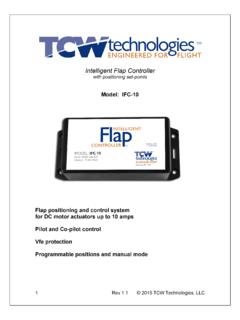Transcription of NFPA requirements for using an isolation flap …
1 The isolation flap valve is a widely used device forpreventing a dust collector explosion frompropagating to other equipment or into theworkspace. In 2014, nfpa 69: Standard onExplosion Prevention Systemswas modified toinclude a new section governing isolation flap valveuse. This article describes the isolation flap valve,explains how the valve works, and discusses the newNFPA requirements . While a dust collection system is designed toprevent dust buildup in the workspace andeliminate dust explosion hazards, the interior ofa dust collector can actually provide ideal conditions for adust explosion. The collected dust and air swirling in theconfined space of the dust collector often just needs aspark or other ignition source to create an explosion thatcan cost millions of dollars in equipment and facilitydamage and process downtime.
2 Even worse, workers canbe seriously injured or deflagration that originates in a dust collector can alsopropagate through ductwork to upstream or downstreamequipment and cause subsequent explosions, which tendto be much more severe than the original explosionbecause of pressure-piling effects and high flame speedstravelling through the ducts. According to nfpa 654,Section , Where an explosion hazard exists, isolation devices shall be provided to prevent deflagrationpropagation between connected equipment in accordancewith nfpa 69: Standard on Explosion PreventionSystems. 1 The isolation flap valve is one such device for preventinga dust collector deflagration from spreading back throughthe dust collection system and possibly out into theworkspace.
3 The valve has gained popularity in recentyears because of its low installation, maintenance, andmonitoring costs, and because its operation doesn trequire an explosion detection device or control the isolation flap valve worksThe isolation flap valve, as shown in Figure 1, consists ofa cylindrical housing with a covered inspection port and aflap blade (or plate) that rotates on a shaft as the valveopens and closes. The valve is mounted in the horizontalinlet duct just upstream from the dust collector. Theminimum and maximum distances from the dust collectorinlet are determined by the valve manufacturer andconfirmed through independent, third-party testing, asdiscussed later in this valve s operation is passive (or flow actuated),meaning that no external input device is required to closethe flap blade when a deflagration occurs.
4 Typically, whenno air is flowing in the system, the isolation flap valve sdefault position is closed. When process air is flowingdownstream during normal operation (Figure 1a), the airpushes the flap blade open and passes through the valve tothe dust collector. If a deflagration occurs in the dustcollector, the pressure wave created causes the process airto reverse and flow upstream in the system (Figure 1b).The pressure wave rapidly pushes the flap blade closed,preventing the deflagration s slightly slower-movingflame front from propagating upstream past the valve andcausing secondary 69 requirements for isolation flap valvesBecause of the isolation flap valve s widespread use, in2014 the nfpa revised nfpa 69 to include a new section(Section ) on flow-actuated flap valves.
5 This new sec-tion details flap valve and system design criteria, applicationlimits, and system certification requirements including: flap -blade flap valve must be equipped with alocking or latching mechanism to prevent the flap blade fromNFPA requirements for using an isolationflap valve on your dust collection system David GrandawIEP TechnologiesPBEAs appeared in CSC Publishingreopening during a deflagration. With no locking mechanismin place, the pressure wave generated by a deflagration couldcause the flap to reopen or bounce as it closes against the valvehousing. This could allow flames and uncombusted materialto travel past the flap blade and ignite additional upstreammaterial, leading to a secondary explosion.
6 Process flap valve must provide forprocess interlocksto signal an immediate, automaticprocess shutdown should the valve close due to adeflagration. An interlock is typically a 24-volt DC switchthat s connected either to an interface panel or through arelay to a PLC. When the valve closes, the switch istripped, shutting down the process and ensuring that feedmaterial doesn t continue to flow into the system and fuela subsequent explosion or flap valve must provide acontinuous monitoring signal to ensure that the valve soperation isn t compromised by dust accumulation. Whilethe process is running, dust can accumulate in the flapvalve and prevent the flap blade from fully closing andsealing during a deflagration.
7 This could allow flames orburning material to pass upstream and cause a secondaryexplosion. Mounting an accumulation sensor at the valve s base tocontinuously sense dust deposits meets this sensor is typically wired into a PLC or interface panel,which initiates an immediate process shutdown if dustdeposits are detected. Some sensors allow you to adjustthe sensitivity depending on the material and desiredaccumulation thickness, which can help to eliminateprocess shutdowns from minor material flap valves rely on flap -blade-position sensing toindicate whether the valve is open or closed, but thisdoesn t necessarily meet nfpa 69 requirements .
8 A flap -blade-position sensor can tell you generally whether theflap blade is open or closed but can t determine if dustaccumulation inside the valve will prevent the valve fromclosing fully and can t detect dust accumulation while theprocess is running. Increasing the inspection frequencyalso doesn t qualify as continuous monitoring or meet only alternative to the continuous-monitoringrequirement is a documented risk assessment along withan inspection protocol and frequency that s acceptable tothe authority having jurisdiction (AHJ). You won t knowwhat, if any, risk assessment and inspection protocol andfrequency will be acceptable to the AHJ when you repurchasing the valve, however, and a risk assessment isdifficult to provide, given the many possible variations inprocess operating conditions such as material, particlesize, humidity, temperature, and airflow.
9 Also, theinspection requirement means that you ll have tofrequently shut down the process and open and visuallyinspect the valve to ensure that no dust is accumulatinginside, which may be difficult depending on the valve sphysical location and costly due to increased downtime. System explosion isolation system sdesign methodology and application range must besupported by appropriate testing and certified by arecognized testing organization acceptable to the testing determines the valve s application limits,which include minimum and maximum airflow, minimumand maximum KStvalue, and the duct mounting location.
10 The minimum KStrequirement is particularly KSt(or dust deflagration index) value is a measure of amaterial s explosivity relative to other often test a flap valve s maximum KStlimitduring certification testing to ensure the valve canwithstand the strongest explosion the material cangenerate, but they pay little attention to the valve sminimum KStvalue. The problem with this approach is thatan isolation flap valve must be able to function under thefull range of deflagration conditions. For a low-KStor leandust-to-air-mixture explosion, the deflagration s pressurewave may not be strong enough to close the flap bladebefore the flame front reaches the valve, which wouldallow the flame to propagate upstream through the valveand potentially cause a secondary explosion.








